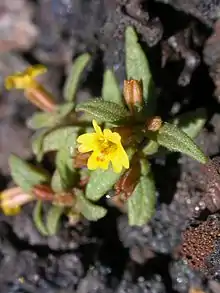Erythranthe suksdorfii
Erythranthe suksdorfii, with the common names Suksdorf's monkeyflower and miniature monkeyflower, is an annual flowering plant in the family Phrymaceae (Lopseed). It was formerly known as Mimulus suksdorfii.[1][2][3][4] A specimen collected in Washington state in 1885 by the self-taught immigrant botanist Wilhelm Nikolaus Suksdorf was identified as a new species by Asa Gray in 1886, who named it in Suksdorf's honor.[5][6] It can easily be misidentified with Erythranthe breviflora, which generally has elliptic leaves rather than the linear or oblong leaves found in E. suksdorfii.[7]
| Erythranthe suksdorfii | |
|---|---|
 | |
| Scientific classification | |
| Kingdom: | Plantae |
| Clade: | Tracheophytes |
| Clade: | Angiosperms |
| Clade: | Eudicots |
| Clade: | Asterids |
| Order: | Lamiales |
| Family: | Phrymaceae |
| Genus: | Erythranthe |
| Species: | E. suksdorfii |
| Binomial name | |
| Erythranthe suksdorfii | |
Distribution and habitat
E. suksdorfii is native to Washington, Oregon, California, Idaho, Montana, Wyoming, Colorado, Nevada, Utah, Arizona, and New Mexico.[5] The plant prefers valleys and foothills in mountainous areas at elevations of 130–2,160 meters (430–7,090 ft).[7] It grows well in wetland-riparian areas that are moist in springtime and forests with Yellow Pine, Red Fir, and/or Lodgepole Pine in subalpine regions.[8] Soils with good drainage are preferred.[9] Its range has been severely impacted by human activity,[7][10] resulting in having the status of "sensitive" from the Bureau of Land Management and United States Forest Service.[7]
Description
E. suksdorfii is a dicot herb.[8] The petals are yellow and have red spots that appear from the throat to the lower corolla lobe, which is only 4–6.5 millimeters (0.16–0.26 in) long.[5] It flowers from mid-April to July, depending upon locality.[11] The calyx is mildly hairy. The leaves are opposite, slender, tapered, and hairy and generally sessile. The plant grows to a height of 3–10 centimeters (1.2–3.9 in).[7]
References
- Barker, W. L. (Bill); et al. (2012). "A Taxonomic Conspectus of Phyrmaceae: A Narrowed Circumscription for MIMULUS, New and Resurrected Genera, and New Names and Combinations" (PDF). Phytoneuron. 39: 1–60. ISSN 2153-733X.
- Beardsley, P. M.; Yen, Alan; Olmstead, R. G. (2003). "AFLP Phylogeny of Mimulus Section Erythranthe and the Evolution of Hummingbird Pollination". Evolution. 57 (6): 1397–1410. doi:10.1554/02-086. JSTOR 3448862. PMID 12894947. S2CID 198154155.
- Beardsley, P. M.; Olmstead, R. G. (2002). "Redefining Phrymaceae: the placement of Mimulus, tribe Mimuleae, and Phryma". American Journal of Botany. 89 (7): 1093–1102. doi:10.3732/ajb.89.7.1093. JSTOR 4122195. PMID 21665709.
- Beardsley, P. M.; Schoenig, Steve E.; Whittall, Justen B.; Olmstead, Richard G. (2004). "Patterns of Evolution in Western North American Mimulus (Phrymaceae)". American Journal of Botany. 91 (3): 474–4890. doi:10.3732/ajb.91.3.474. JSTOR 4123743. PMID 21653403. S2CID 11035527.
- "Mimulus suksdorfii (Suksdorf's Monkeyflower)". Southwest Colorado Wildflowers. Retrieved 11 February 2017.
- Love, Rhoda M. (Fall 1998). "Wilhelm Nikolaus Suksdorf (1850–1932) Pioneer Botanist of the Pacific Northwest" (PDF). Pacific Northwest Quarterly: 1. Archived from the original (PDF) on 2016-03-04. Retrieved 2017-02-12.
- "Erythranthe suksdorfii (A. Gray) N. S. Fraga" (PDF). Washington Department of Natural Resources. Retrieved 11 February 2017.
- "Mimulus suksdorfii (A. Gray)". Calflora. Retrieved 11 February 2017.
- Rundel, Philip W.; Gibson, Arthur C.; Sharifi, M. Rasoul (2008). "The Alpine Flora of the White Mountains, California". Madroño. 55 (3): 202–215. doi:10.3120/0024-9637-55.3.202. JSTOR 41431655. S2CID 83819837.
- "Erythranthe suksdorfii (A. Gray) N. S. Fraga". SEInet. Retrieved 11 February 2017.
- "Erythranthe suksdorfii". Bruke Museum of Natural History and Culture, University of Washington. Retrieved 11 February 2017.
External links
 Media related to Erythranthe suksdorfii at Wikimedia Commons
Media related to Erythranthe suksdorfii at Wikimedia Commons Data related to Erythranthe suksdorfii at Wikispecies
Data related to Erythranthe suksdorfii at Wikispecies